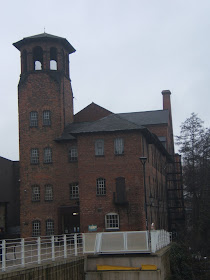Derby's Cathedral Quarter is full of gates; Friar Gate, St Mary's Gate, Iron Gate and this one, Sadler Gate, referring to the craft of the saddler. The word is evidence of Derby's Viking past, as, in Viking parlance, 'gate' means 'street'. It was in 874 AD that the Danes first occupied the area and named the settlement Deoraby (Village of the Deer) and the town then became one of the `Five Boroughs’ of the Danelaw.
Sadler Gate is an interesting mix, having quite a rich history, but also being at the heart of Derby's bar and club culture. One building which falls into both categoreis is The Old Bell Hotel on the left of the photograph, which was a coaching inn dating back to around the mid 17th century. Room 29 of this establishment is said to be haunted by young servant girl who was murdered by the Jacobite army in 1745.
If you look along the line of the Gate, most of the buildings appear to have flat roofs, but this is actually an illusion created by a series of false facades, built because the architects wanted uniformity along the street.
Branching off from Sadler Gate are a series of little passages and yards; most notably Blacksmiths Yard. I had an interesting experience here last summer. Derby has a significant deaf community. A friend had just completed her level 2 British Sign Language course and been told by her tutor of a new cafe opening in Blacksmith's Yard which would be run by, and cater for, deaf people. It was recommended as a place to socialise and practice her signing. A group of four of us duly went to the cafe. When we arrived, we sat outside in the sunshine and were served our coffee. After a little while, one of the owners of the cafe came out for a chat. It was only during the course of this conversation that we learned that we were a tad premature! The cafe was not yet actually open for business!! I can't think of many other places where coffee would be cheerfully served from a not-yet-open cafe.


















































